The Magadha Empire lost power to the Moorish Empire, which ruled from 322 BCE to 185 BCE over large parts of eastern and northern India. At its peak, the empire covered parts of what is now Iran and almost all of India. However, they did not cover the southern tip of the peninsula. Chandragupta Maurya started the empire after Alexander of Macedon left the western borders of India. Chandragupta took over the border states, assembled an army, marched on the Magadha empire, killed the cruel one, hated the king and took the throne. He set up the Mauryan dynasty in this way. Kautilya, also known as Chanakya, was his prime minister. He helped him come to power and gave him advice. Kautilya wrote Arthashastra, a book about being a king and ruling a country.
How the Moorish Empire Began
Before Maurya came to power, northern India consisted of many large and small states. This period was the classical age in the history of ancient India. It was a time when Buddhism and Jainism, two new religions, came into being.
Magadha was one of the largest of these states. It was on the edge of the Aryan cultural area, in the eastern part of the Ganges plain. Other states seemed to think that Magadha was crazy in the history of India. Since it was on the outskirts of the Aryan world, perhaps not so strict people followed the ancient Vedic religion in northern India. The two non-Orthodox religions, Jainism and Buddhism, flourished and were sponsored by the Magadha monarchs here in their early days.
The borders of Magadha grew over a century or more. The Nanda Empire covered a large area in northern India under the rulers of the Nanda Dynasty (424-322 BC).
Chandragupta Maurya
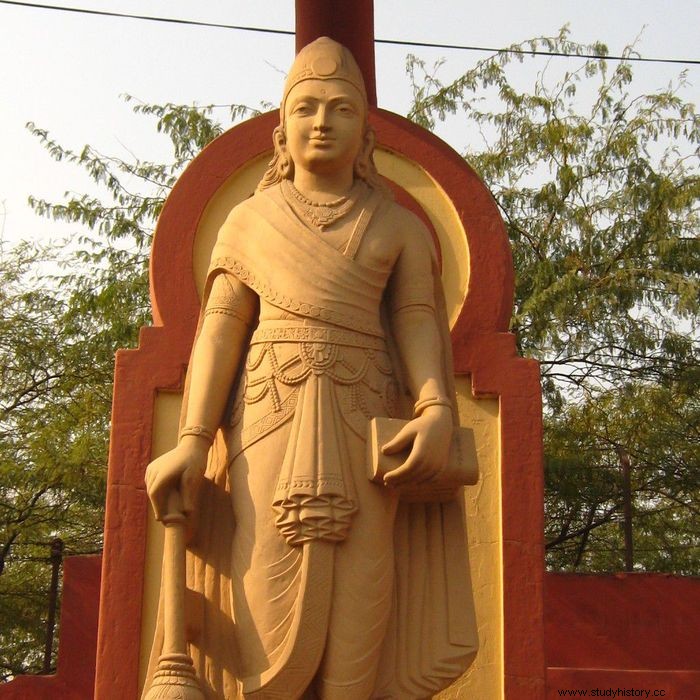
In ancient Indian history, the Mauryan period began when Alexander the Great took over northwestern India in 326 BCE. This conquest seems to have made the Aryan states in the area less politically stable. This made it possible for Chandragupta Maurya (who ruled from 322-298 BCE) to become the first great conqueror in Indian history.
Chandragupta took the throne of Maghada from the last Nanda king. He then took over the rest of northern India which was still outside the borders of Maghada. He defeated Seleucus, one of Alexander's successors who had taken control of most of his conquests in Asia. In exchange for 500 war elephants, a treaty from 305 BCE gave him Seleucus' easternmost provinces, which extended into Afghanistan and eastern Iran.
During his time in power, he built on what the Nanda kings had done and set up a strong central government. Chanakya, his brilliant and capable Prime Minister, did this work.
Bindusara, Chandragupta's son, succeeded him (reigned 298-272 BCE). Although we do not know much about him, we can assume that he was a good leader. He spread Mauryan power deep into central India, leaving his son Ashoka a large, unified state.
Ashoka
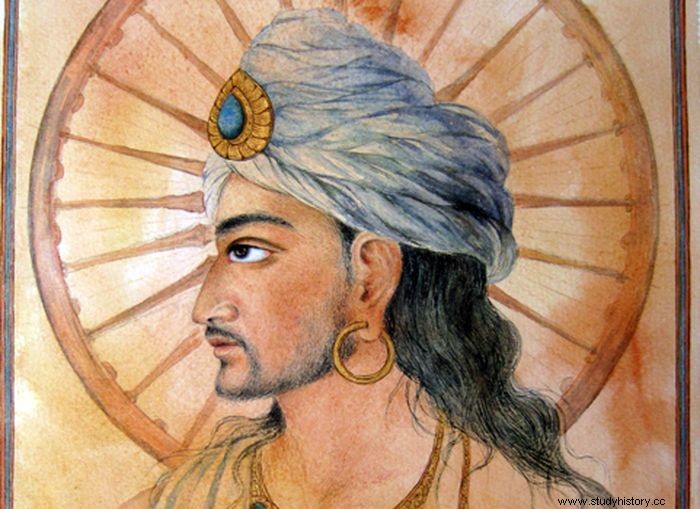
Ashoka (also spelled Asoka; reigned from 272-232 BCE) was one of the most exciting and well-liked rulers in the history of India and the world. After a bloody war in eastern India against Kalinga, Ashoka gave up fighting and became a Buddhist. He decided that from that point on, he should rule in peace.
He worked hard to spread Buddhism and sent missions to Sri Lanka and Southeast Asia, led by his son Mahinda. Here they laid the foundation for Buddhism to become the main religion in the future. He also sent messages to the Greek-speaking kingdoms of the west, which had divided Alexander the Great's territories. Here they do not seem to have changed much.
We can still see the pillars that Ashoka set up around his empire. He wrote royal orders and encouraged his people to come to terms with them. These orders and suggestions show how Ashoka thought. What comes over is a kind, tolerant, but firm leader who wants justice and happiness for all under his rule.
The importance of Chanakya in the establishment of the Mauryan Empire

Chanakya, also known as Kautilya, is said to have traveled to the kingdom of Magadha, which at the time was significant, militarily strong and feared by its neighbors. However, the monarch of Magadha, Dhana Nanda, from the Nanda dynasty is said to have humiliated Chanakya while he was there. As a result, Chanakya vowed revenge and promised to destroy the Nanda Empire as part of his promise.
Chanakya inspired Chandragupta Maurya and his troops to conquer the kingdom of Magadha and was instrumental in their success. Chandragupta gathered many young men and the resources needed for his army to fight a wide range of battles using his intelligence network. However, King Dhana Nanda's corrupt and oppressive government had angered these young men from all over Magadha and nearby regions. As a result, Chandragupta's army had to fight a long series of battles.
Mauryan Government
Chanakya, Chandragupta's prime minister, appears to have been one of the critical builders of Maurya's power. He is primarily the author of Arthashastra, a practical guide to governance. Although most academics agree that this book was created long after the Maurya had passed away, many believe that it depicts the realities of the period. In any case, it seems that Chanakya has put in place a well-organized military and civilian administration on which the Mauryan kings could establish a stronghold.
A council of advisers advised Maurya rulers, and an intricate administrative organization served them. The establishment of provinces took place throughout the empire, each led by a royal family member. Local rulers seem to have been kept in position under them if they remained loyal to Maurya and quickly transferred revenue from their provinces to the imperial treasury in the capital. On the other hand, the surveillance of their operations by top royal officials took place through regular inspections and in the guise of Mauryan spies. The Mauryan administration had a sophisticated spy network, which Chandragupta mainly exploited.
A hierarchy of royal officials was responsible for administering the cities of the empire, including preserving public infrastructure such as roads and wells and administering justice. The basis of Mauryan's authority was ultimately its powerful army, which was considered (perhaps erroneously) the world's most comprehensive by Greek and Roman historians. An estimate estimates the number of elephants, horses and troops at 700,000 XNUMX, clearly exaggerated.
The Economy of the Mauryan Empire
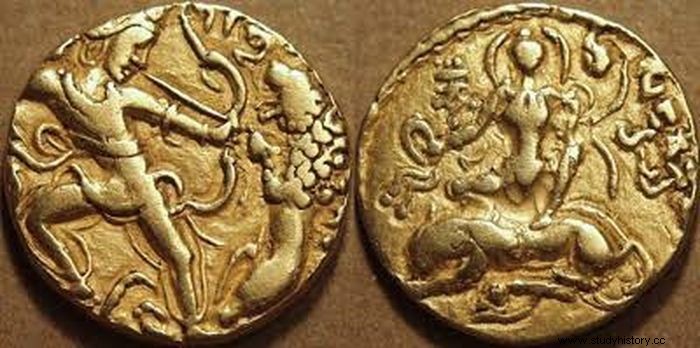
Trade and entrepreneurship were public-private:the state could own and run a business as citizens. Taxes financed royal expenses and war booty, and the king had surpluses of timber land, woodland, hunting groves and production facilities. State monopolized currency, mining, salt production, weapons production and boat building.
Most people were farmers, and agriculture was taxed. The guilds had executive and judicial power and acted as banks. Sales of goods could not take place at the place where the production took place, so they had to be transported to the market. The imposition of motorway and river crossing charges and import / export charges also took place. State inspectors checked weights and targets and set wholesale prices. Gold, bronze and copper coins were standard. Debt securities secured interest-bearing loans.
The primary route over the Kingdom and Western Greece was well maintained and monitored, with columns and signs indicating distances and detours. In addition, the state sent ships down the Ganges and its tributaries and to Sri Lanka, China and African and Arab ports to exterminate pirates.
Administration
The king ruled the army, the government, the courts and the legislature. He consulted the Prime Minister, the Minister of Finance, the General and other ministers. It was a division of the kingdom into provinces with princely governors with city and village administrations. King employed a huge bureaucracy. Then, as now, the top of the civil service was far from the bottom. The expectation of senior officials was to control their divisions with such high salaries.
There were departments for industrial art, production facilities, general trade and commerce, foreigners, births and deaths, trade taxes, land and irrigation, agriculture, forests, metal foundries, mines, highways and public structures. In addition, senior personnel needed to carry out inspection missions to verify bureaucratic efficiency.
Empire had a large espionage network and reputable army. The third Mauryan ruler, Ashoka, did not disband the king's army, and the soldiers were the second largest group after peasants. Soldiers were to fight, and there was no strength to do anything else for the monarch; when there was no war, they could do as they pleased. Infantry, cavalry, navy, tanks, elephants and logistics had different departments. Soldiers received salaries, weapons and equipment from the state, while infantrymen wore bows at man's lengths, buckles in cowhide, spears and broadswords, and barback cavalry used lances and bucklers.
Religion
Buddhism flourished during the reign of Maurya. During this time of ancient India, especially during Ashoka, Buddhism is believed by some scholars to have become the dominant religion on the Indian subcontinent. But Jainism also grew, especially among urban merchants, who, as we have seen, experienced a period of prosperity. The merchants occupied a marginal position in the early Hindu social order. They were probably less tolerant than other socio-economic classes of the old Brahmin supremacy in religious affairs and were therefore drawn more to the emerging heterodox religions of Buddhism and Jainism.
The cities of the empire were administered directly by a hierarchy of royal officials responsible for preserving public infrastructure such as roads and wells and the administration of justice.
The Legacy of the Mauryan Empire
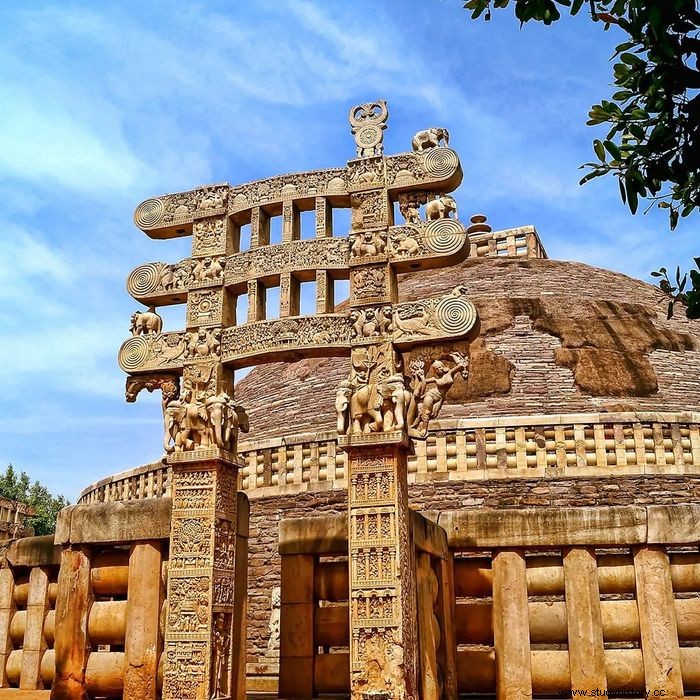
In later Indian records, the Mauryan Empire was just one of the many kingdoms that made up India's long and complicated history. Consequently, it received no special attention. However, the towns where Maurya carried out most of the building work are still inhabited today, so their remains were buried under streets and buildings used by later generations.
This great empire was almost completely forgotten, apart from the brief mentions of some stories. This fact is surprising since people in other parts of the world place great emphasis on their ancient empires. In the 19th century, however, some British officials began to wonder who built the strange pillars all over India. Why are they hundreds or even thousands of miles apart? What do the inscriptions on them mean?
Then, slowly, the truth about the Maurya began to emerge. When it was found that the construction of these pillars was by Ashoka, a king whose empire covered a large part of India and even parts of other countries, it became clear that this was a decisive construction in the history of ancient India.
The effect of the Moorish empire on world history
The Mauryan Empire was the first great empire of ancient India, making it a significant part of world history. It was one of the most powerful empires in antiquity. It was as big as the Persian, Roman and Han empires, but it did not last long.
Connections to other parts of the globe
The administration of Maurya maintained frequent diplomatic ties with the Greek-speaking kingdoms in the west. This fact was especially true of the Seleucid Empire, which was the closest, although there is evidence of relations with Macedonia, Egypt and other Hellenistic countries. Megethsenes was one of the Seleucid diplomats of the Mauryan court, and his report, Indica, provides a wealth of information about India during the Mauryan era. In addition, there were probably marital relations between the royal families of the Seleucid and Mauryan empires.
Under Ashoka, these diplomatic contacts also included trade missions and missionary excursions. For example, in 251 BCE, Ashoka's son Mahinda embarked on a missionary journey to Sri Lanka that brought Buddhism.
The Growth of Indian Culture
The Aryan culture was spread over most of India by the Moorish empire. It helped the economies of areas that had been on the outside before to be combined with Aryan society. Before the Mauryans took over, most of Deccan, a large plateau in the middle of India, was not part of an Aryan civilization. Under Maurya, it became part of the Aryan world and would be a crucial part of India's history for years to come. By doing so, the Moorish empire greatly expanded the boundaries of ancient Indian civilization, making it a more potent force in world history.
In time, Deccan and later South India, which did not become part of what we think of as Indian culture before the Maurya Empire, would be crucial to the growth of trade networks in the Indian Ocean and serve as a link between the Middle East and Southeast. -Asia for goods and ideas.
How Buddhism Spread
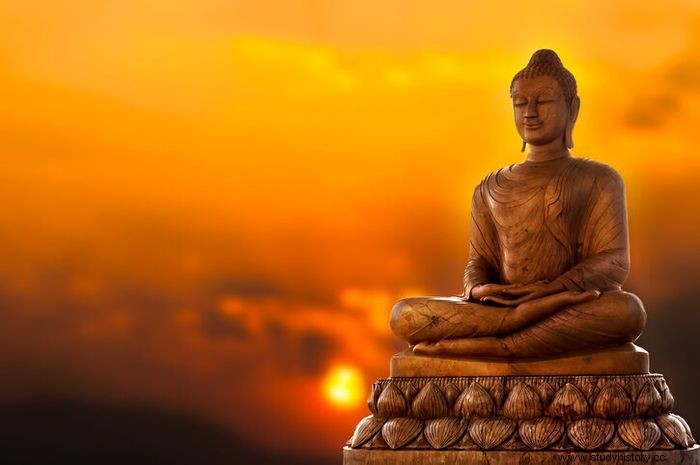
The Moorish Empire was an essential part of how Buddhism spread. Buddhism became a major religion in ancient India during the Mauryan period, which was a time when Ashoka was in charge of government policy. This rule will have helped to make the subcontinent a place where Buddhism could spread to other parts of Asia in the future.
The Mauryas also helped send Buddhist missionaries to other parts of the world. Most of these countries did not become Buddhists until much later, but the ruling class in at least one country, Sri Lanka, appears to have been converted directly because of these Maurya missions. The great Maurya king Ashoka is partly responsible for the number of Buddhists now living in China, Japan, Korea, Vietnam, Tibet, Burma, Thailand, Laos and Cambodia.
A good leader
Ashoka is a rare example of an excellent and intelligent leader. There was no visibility of his great personality in the history books until the 19th century, but it has made everyone studying world history think. As more people begin to study world history, his example can only become better known.
The decline of the Moorish empire
After Ashoka's death, or sooner, the empire began to fall. Satavahana, a powerful empire in central India, emerged, while Bactria, in present-day Afghanistan, spread to India. By the middle of the 2nd century BC, the old empire had sunk to its core area. The Maurya dynasty was gone. Then, in 180 BCE, the last Maurya monarch was assassinated by the prime minister. This happened while he was inspecting his troops, and the Shunga dynasty took control.
Magadha survived. The Kanva dynasty followed the Shunga dynasty in 73 BCE, which collapsed in 30 BCE. After that, control of the empire happened to pass to neighboring powers and obscure rulers. Finally, at the end of the 3rd century AD, a new dynasty of monarchs formed in the Magadha Gupta Empire. They were India's largest and most prosperous empire since Maurya.
The probable causes of the decline are as follows:
- First, the legacy of Ashoka was of weak monarchs who could not control such a large empire.
- The second factor is related to Mauryas' weak imperial institutions. Mauryan's rule depended on the king's skill and power.
- Later experiences from around the world, such as in China and the Roman Empire, indicate that a bureaucracy can quickly become divided among its followers. This is happening due to overwhelming ministers and provincial governors. In the late Maurya periods, something similar may have led to the dissolution of vast provinces.
The conclusion
In part, the success of the Mauryan Empire led to its spread. Aryan culture flourished over most subcontinents during the Moorish era of peace and harmony. Cities and towns grew far from the historic centers of civilization as Mauryan administrative hubs. When the firm grip of the early Mauryan rulers was gone, other autonomous nations were quickly formed.
